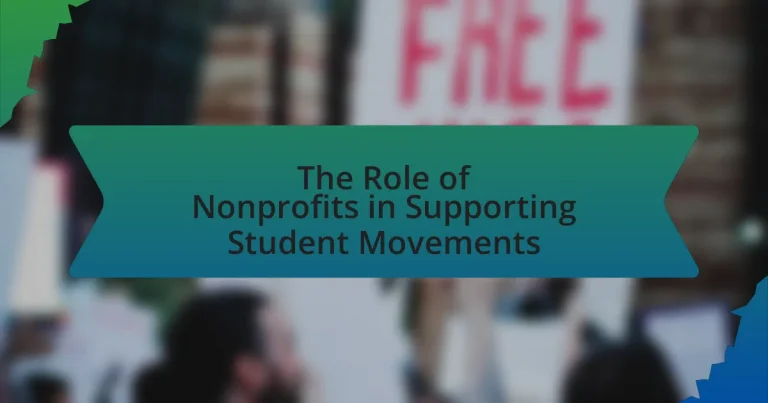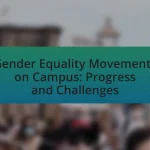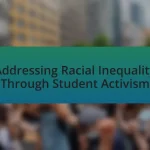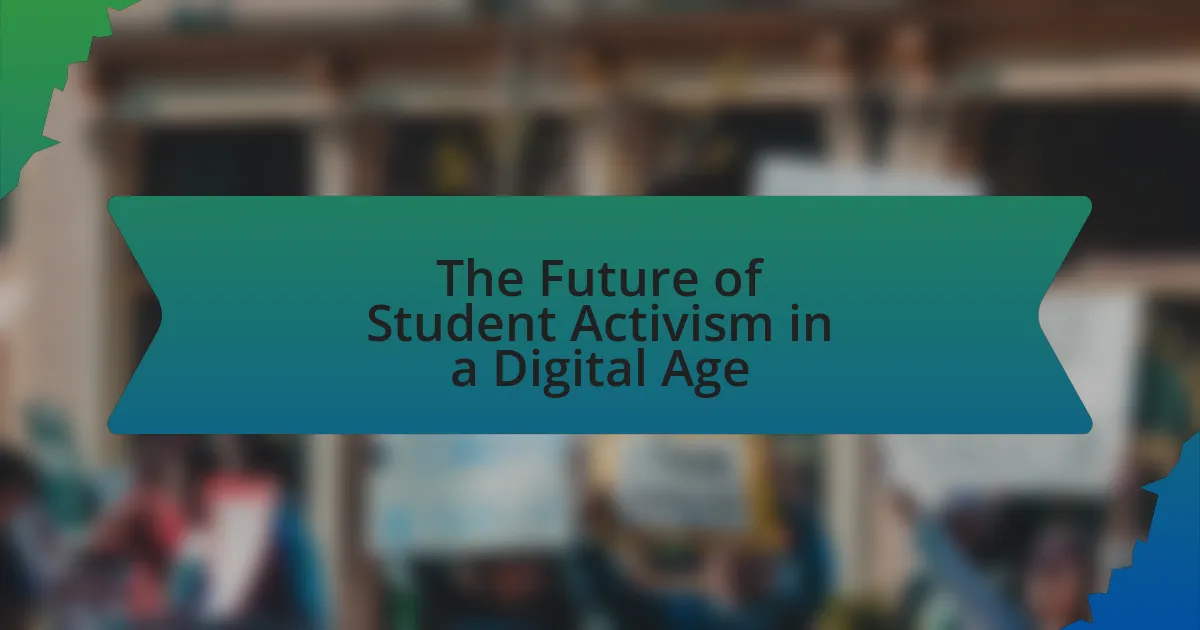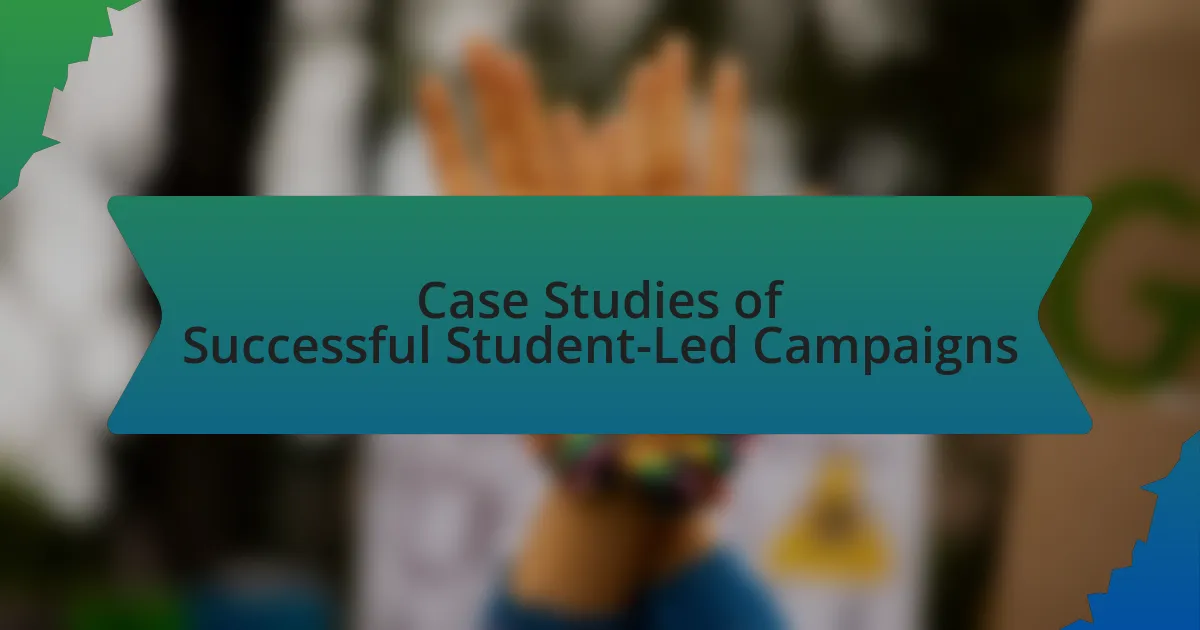Nonprofits play a vital role in supporting student movements by providing essential resources, advocacy, and organizational support. They engage with students through funding, mentorship, and collaborative initiatives, enabling students to address issues such as social justice and educational reform. The article explores the strategies nonprofits use to empower student initiatives, the challenges they face, and the importance of community engagement. Additionally, it highlights successful case studies that demonstrate effective nonprofit-student collaborations and offers practical steps for enhancing support for student movements.
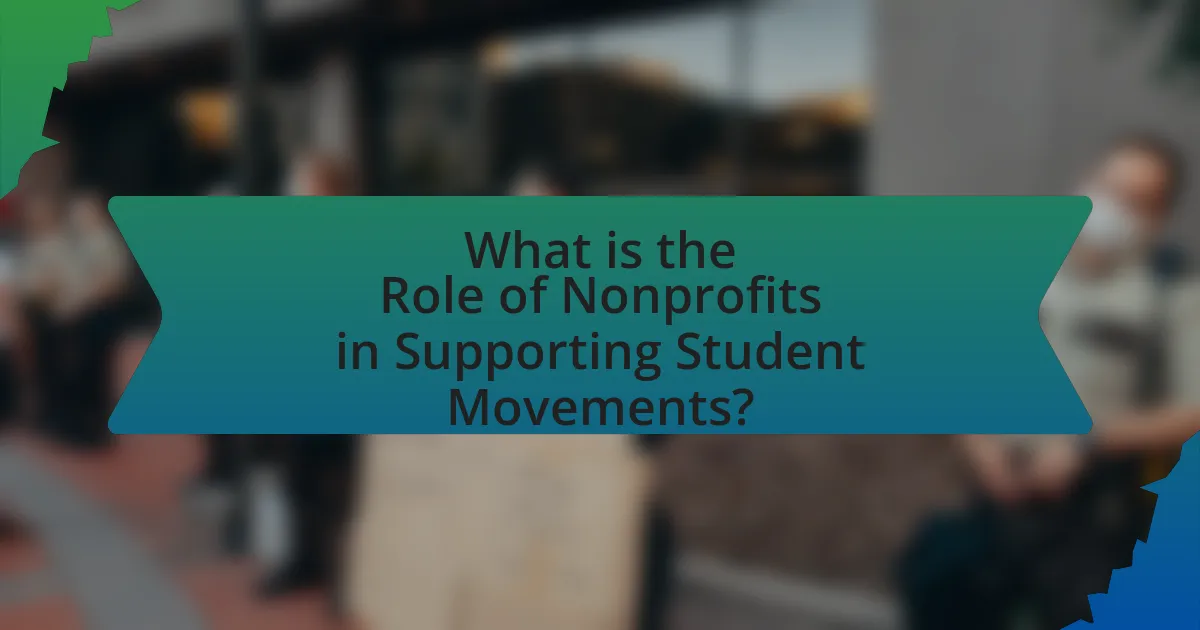
What is the Role of Nonprofits in Supporting Student Movements?
Nonprofits play a crucial role in supporting student movements by providing resources, advocacy, and organizational support. These organizations often mobilize funding, facilitate training, and offer platforms for students to voice their concerns and demands. For instance, nonprofits like the Student Nonviolent Coordinating Committee (SNCC) historically provided essential support during the Civil Rights Movement, helping to organize protests and educate students on activism. Additionally, contemporary nonprofits continue to assist student movements by offering legal aid, mentorship programs, and networking opportunities, which empower students to effect change in their communities.
How do nonprofits engage with student movements?
Nonprofits engage with student movements by providing resources, advocacy, and platforms for collaboration. They often support student-led initiatives through funding, training, and mentorship, enabling students to amplify their voices on issues such as social justice, environmental sustainability, and educational reform. For instance, organizations like the Student Nonviolent Coordinating Committee historically mobilized students during the Civil Rights Movement, demonstrating the effectiveness of nonprofit involvement in fostering activism. Additionally, nonprofits frequently partner with student groups to organize events, campaigns, and awareness programs, thereby enhancing the impact of student movements on local and national levels.
What strategies do nonprofits use to support student initiatives?
Nonprofits support student initiatives through funding, mentorship, and advocacy. They provide financial resources to help students launch projects, often through grants or scholarships, which can significantly enhance the viability of student-led initiatives. For example, organizations like the Gates Foundation have invested millions in educational grants aimed at empowering students. Additionally, nonprofits often offer mentorship programs that connect students with experienced professionals, fostering skill development and networking opportunities. Advocacy efforts by nonprofits also play a crucial role, as they work to influence policy changes that benefit student initiatives, such as increased funding for educational programs. These strategies collectively enhance the capacity of students to effect change within their communities.
How do nonprofits collaborate with student organizations?
Nonprofits collaborate with student organizations by providing resources, mentorship, and opportunities for joint initiatives. These collaborations often involve nonprofits offering funding, training, or access to networks that enhance the capabilities of student groups. For instance, a study by the National Council of Nonprofits highlights that 70% of nonprofits engage with educational institutions to foster community service projects, demonstrating the effectiveness of such partnerships in achieving common goals.
Why are nonprofits important for student movements?
Nonprofits are important for student movements because they provide essential resources, advocacy, and support that empower students to effect change. These organizations often offer funding, training, and networking opportunities that enhance the capacity of student movements to organize effectively. For instance, nonprofits like the Student Nonviolent Coordinating Committee (SNCC) historically played a crucial role in the Civil Rights Movement by mobilizing students and providing them with the tools necessary for activism. Additionally, research from the National Youth Leadership Council indicates that nonprofit involvement increases student engagement and leadership skills, which are vital for successful movements.
What unique resources do nonprofits provide to students?
Nonprofits provide unique resources to students, including mentorship programs, scholarships, and access to educational materials. These organizations often connect students with experienced professionals who offer guidance and support, enhancing their academic and career prospects. For instance, according to the National Mentoring Partnership, students with mentors are 55% more likely to enroll in college and 78% more likely to volunteer regularly in their communities. Additionally, nonprofits frequently offer scholarships that alleviate financial burdens, enabling students to pursue higher education. Furthermore, they provide access to educational resources such as tutoring services, workshops, and online courses, which are essential for academic success.
How do nonprofits amplify student voices in advocacy?
Nonprofits amplify student voices in advocacy by providing platforms for engagement, resources for education, and opportunities for collaboration. These organizations often facilitate workshops, training sessions, and campaigns that empower students to articulate their concerns and influence policy decisions. For instance, organizations like the Student Advocacy Center have successfully mobilized students to participate in legislative processes, demonstrating that structured support can lead to increased student representation in advocacy efforts.
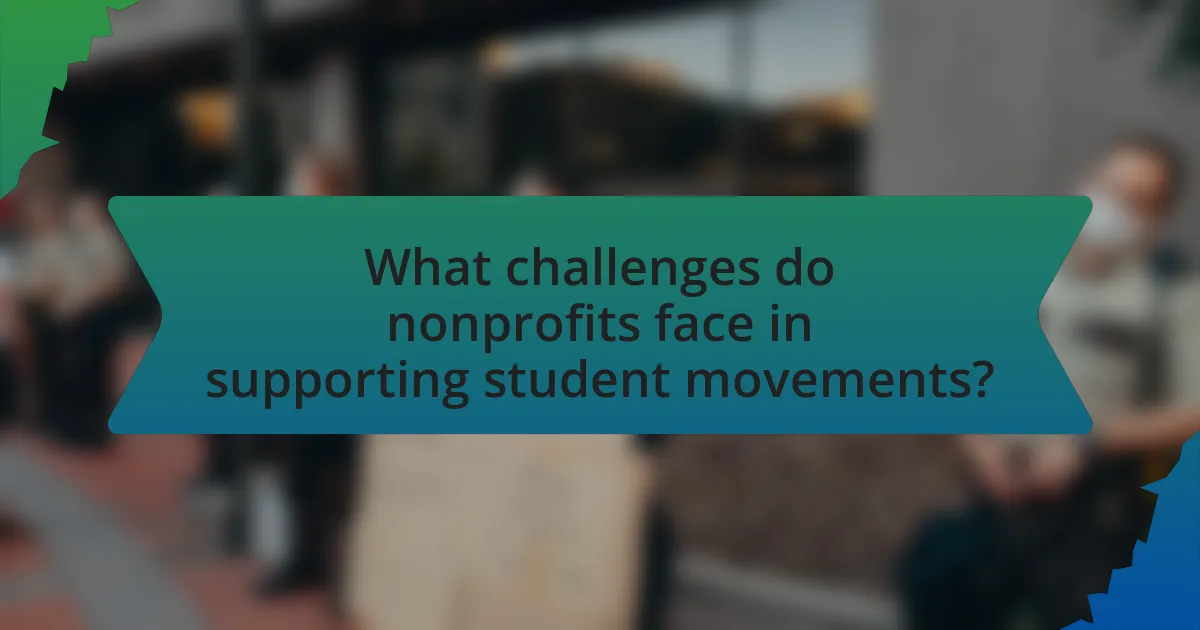
What challenges do nonprofits face in supporting student movements?
Nonprofits face several challenges in supporting student movements, primarily including funding limitations, organizational capacity, and navigating political landscapes. Funding limitations restrict nonprofits’ ability to provide adequate resources and support for student initiatives, as many rely on grants and donations that may not be consistently available. Organizational capacity issues arise when nonprofits lack the staff or expertise to effectively engage with and support diverse student groups, which can hinder their impact. Additionally, navigating political landscapes poses a challenge, as nonprofits must often contend with varying levels of governmental support or opposition, which can affect their ability to advocate for student causes. These challenges collectively impede the effectiveness of nonprofits in fostering and sustaining student movements.
How do funding limitations impact nonprofit support for students?
Funding limitations significantly reduce nonprofit organizations’ ability to support students effectively. When nonprofits face budget constraints, they often have to cut programs, limit resources, or reduce the number of students they can assist. For instance, a study by the National Council of Nonprofits found that 70% of nonprofits reported a decrease in funding, which directly correlates with a reduction in services offered to students, such as scholarships, mentorship programs, and educational resources. This lack of financial support can hinder students’ academic success and limit their opportunities for personal and professional development.
What are the common sources of funding for nonprofits?
Common sources of funding for nonprofits include individual donations, grants from foundations, government funding, corporate sponsorships, and fundraising events. Individual donations often represent a significant portion of nonprofit revenue, with studies indicating that they account for approximately 70% of total contributions. Grants from foundations provide targeted financial support for specific projects or initiatives, while government funding can come from local, state, or federal sources aimed at addressing community needs. Corporate sponsorships offer financial backing in exchange for brand visibility, and fundraising events engage the community to raise funds while promoting the nonprofit’s mission. These diverse funding sources enable nonprofits to sustain their operations and support their initiatives effectively.
How can nonprofits overcome funding challenges?
Nonprofits can overcome funding challenges by diversifying their revenue streams. This approach includes seeking grants from various foundations, engaging in fundraising events, and developing partnerships with businesses for sponsorships. According to the National Council of Nonprofits, organizations that diversify their funding sources are more resilient and better equipped to withstand economic fluctuations. Additionally, leveraging online crowdfunding platforms has proven effective, with a report from Nonprofit Quarterly indicating that nonprofits raised over $1 billion through crowdfunding in 2020 alone. By implementing these strategies, nonprofits can enhance their financial stability and continue supporting student movements effectively.
What legal and regulatory challenges do nonprofits encounter?
Nonprofits encounter various legal and regulatory challenges, including compliance with tax laws, fundraising regulations, and governance requirements. For instance, in the United States, nonprofits must adhere to Internal Revenue Service regulations to maintain their tax-exempt status, which includes filing annual returns and ensuring that their activities align with their stated charitable purposes. Additionally, many states impose specific fundraising laws that require nonprofits to register before soliciting donations, which can vary significantly across jurisdictions. These complexities can lead to legal risks if nonprofits fail to comply, potentially resulting in penalties or loss of tax-exempt status.
How do regulations affect nonprofit involvement in student activism?
Regulations significantly influence nonprofit involvement in student activism by establishing legal frameworks that dictate how these organizations can engage in political activities. For instance, the Internal Revenue Service (IRS) restricts 501(c)(3) nonprofits from participating in political campaigns, which limits their ability to support student movements that may have political implications. Additionally, state laws may impose reporting requirements and restrictions on funding sources, affecting how nonprofits mobilize resources for student activism. These regulations can either facilitate or hinder the capacity of nonprofits to advocate for student rights and social change, as evidenced by the varying levels of engagement seen in states with more permissive versus restrictive laws regarding nonprofit political activities.
What are the implications of nonprofit status on advocacy efforts?
Nonprofit status significantly impacts advocacy efforts by limiting the political activities that organizations can engage in while still maintaining their tax-exempt status. Specifically, nonprofits are restricted from participating in partisan political campaigns and must adhere to the IRS guidelines that allow only a limited amount of lobbying activities, typically defined as no more than 20% of their total expenditures. This regulatory framework can constrain the ability of nonprofits to fully advocate for policy changes or engage in direct political action, which may hinder their effectiveness in supporting student movements. For instance, the National Council of Nonprofits highlights that while nonprofits can advocate for issues related to their mission, they must navigate these restrictions carefully to avoid jeopardizing their tax-exempt status.
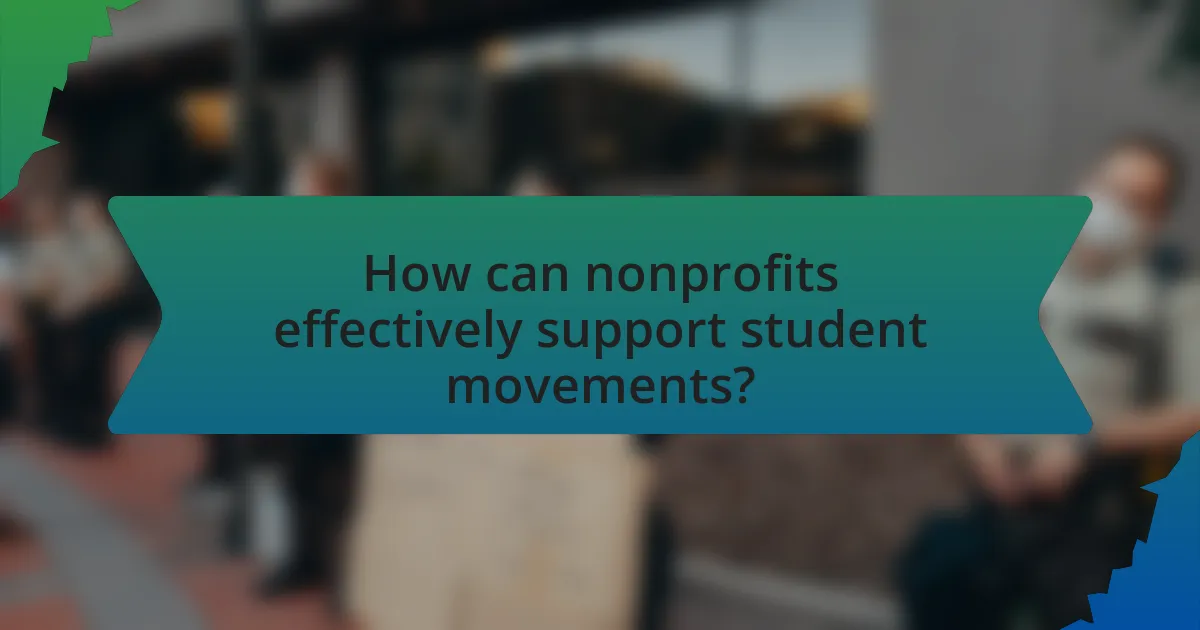
How can nonprofits effectively support student movements?
Nonprofits can effectively support student movements by providing resources, advocacy, and strategic guidance. By offering financial support, nonprofits enable students to organize events, campaigns, and initiatives that amplify their voices. For instance, organizations like the Student Nonviolent Coordinating Committee (SNCC) historically provided funding and logistical support to civil rights student activists, which significantly enhanced their impact. Additionally, nonprofits can advocate for policy changes that align with student goals, leveraging their networks to influence decision-makers. Research shows that nonprofits engaged in advocacy can increase the likelihood of policy success by 30%. Furthermore, nonprofits can offer training and mentorship programs to equip student leaders with essential skills in organizing, communication, and negotiation, thereby strengthening the overall effectiveness of student movements.
What best practices should nonprofits adopt when working with students?
Nonprofits should adopt inclusive engagement strategies when working with students to ensure their voices are heard and valued. This involves actively involving students in decision-making processes, which fosters a sense of ownership and empowerment. Research indicates that student-led initiatives are more effective in addressing their specific needs, as highlighted in the study “Youth Participation in Decision-Making: A Review of the Literature” by the International Youth Foundation. Additionally, nonprofits should provide mentorship and resources tailored to students’ interests and goals, enhancing their skills and confidence. By creating collaborative partnerships with educational institutions, nonprofits can leverage existing support systems and amplify their impact on student movements.
How can nonprofits ensure they are meeting student needs?
Nonprofits can ensure they are meeting student needs by conducting regular assessments and gathering feedback from students. This approach allows organizations to identify specific challenges and requirements faced by students, enabling them to tailor their programs effectively. For instance, a study by the National Center for Education Statistics found that 70% of students reported needing more academic support, highlighting the importance of targeted interventions. By implementing surveys, focus groups, and direct communication channels, nonprofits can continuously adapt their services to align with the evolving needs of the student population.
What role does community engagement play in nonprofit strategies?
Community engagement is essential in nonprofit strategies as it fosters trust, collaboration, and resource sharing between organizations and the communities they serve. By actively involving community members in decision-making processes, nonprofits can better understand local needs and tailor their programs accordingly, leading to increased effectiveness and sustainability. Research indicates that nonprofits with strong community ties are more likely to achieve their goals; for instance, a study by the Stanford Social Innovation Review found that organizations engaging with their communities saw a 30% increase in program participation and a 25% increase in funding. This demonstrates that community engagement not only enhances program relevance but also strengthens organizational capacity and impact.
What are some successful case studies of nonprofit support for student movements?
Successful case studies of nonprofit support for student movements include the work of the United States Student Association (USSA) and the National Education Association (NEA). The USSA, through its advocacy and funding, played a crucial role in the 2011 Occupy Wall Street movement, mobilizing students to address issues of economic inequality and student debt. The NEA has supported various student-led initiatives, such as the “Students for Education Reform” campaign, which aimed to influence education policy and promote equitable access to quality education. These nonprofits provided resources, training, and platforms for students to amplify their voices, demonstrating effective collaboration that led to significant policy discussions and changes in educational reform.
What lessons can be learned from these successful collaborations?
Successful collaborations between nonprofits and student movements demonstrate the importance of shared goals and mutual support. These partnerships highlight that aligning missions fosters effective advocacy and resource sharing, which enhances the impact of both parties. For instance, the collaboration between the United Students Against Sweatshops and various labor organizations successfully mobilized student activism, leading to significant policy changes in universities. This illustrates that when nonprofits leverage their networks and expertise, they can amplify student voices and drive systemic change. Additionally, these collaborations teach that sustained engagement and open communication are crucial for building trust and ensuring long-term success in advocacy efforts.
How can these case studies inform future nonprofit strategies?
Case studies can inform future nonprofit strategies by providing evidence-based insights into effective practices and approaches. For instance, analyzing successful nonprofit interventions in student movements reveals the importance of community engagement and collaboration with student leaders, which enhances the impact of initiatives. Additionally, these case studies often highlight the significance of adaptive strategies that respond to the evolving needs of students, as seen in organizations that adjusted their programs based on feedback and changing circumstances. This adaptability is supported by data showing that nonprofits that actively incorporate stakeholder input achieve higher levels of engagement and success. Thus, leveraging lessons from case studies enables nonprofits to refine their strategies, ensuring they are more relevant and effective in supporting student movements.
What practical steps can nonprofits take to enhance their support for student movements?
Nonprofits can enhance their support for student movements by providing funding, resources, and advocacy. By allocating grants specifically for student-led initiatives, nonprofits can empower students to implement their projects effectively. Additionally, offering training programs in leadership, organizing, and advocacy equips students with essential skills to mobilize their peers. Nonprofits can also create partnerships with educational institutions to facilitate workshops and events that amplify student voices. Furthermore, advocating for policy changes that benefit student movements can create a more supportive environment. Research shows that nonprofits that actively engage with student groups can significantly increase the impact of their initiatives, as evidenced by successful collaborations in various regions.
